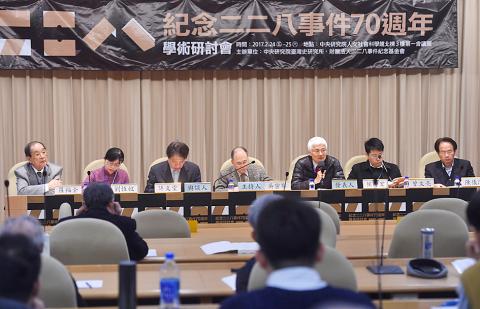Evidence shows that Chiang Kai-shek (蔣介石) should be held responsible for the 228 Incident, an academic said on Thursday.
A document dated March 2, 1947, requesting the dispatch of at least a regiment to help quell protests, which was read and approved by Chiang, and the fact that then-Taiwan governor Chen Yi (陳儀) and Peng Meng-chi (彭孟緝), a major-general at the Kaohsiung garrison, were promoted after the crackdown demonstrates that Chiang has ultimate responsibility for the incident, said Chen Yi-shen (陳儀深), an associate research fellow at Academia Sinica’s Institute of Modern History.
Chen Yi-shen made the statement at a conference in Taipei to launch six more volumes of the Collected Files of the 228 Incident published by Academia Historica.

Photo: Chien Jung-fong, Taipei Times
The 228 Incident was triggered by a clash between government officials and an illegal cigarette vendor in Taipei on Feb. 27, 1947. The event quickly turned into an anti-government uprising and was put down by the then-Nanjing-based Chinese Nationalist Party (KMT) government in China.
An estimated 18,000 to 28,000 people were killed during the crackdown, which lasted into early May, according to an investigation commissioned by the Cabinet in 1992.
The six volumes — Vol. 19-24 in the series — include files about the incident from the Presidential Office, the Changhua County Government and what was at the time the Taichung County government.
President Tsai Ing-wen (蔡英文) has promised to publish a report on transitional justice within three years and ordered the collection of government documents detailing political and other types of persecution, Academia Historica director Wu Mi-cha (吳密察) said.
The National Archives Administration has identified about 13,000 cases relating to the 228 Incident and political persecution, Wu said.
Tsai said that her administration has an obligation to determine the truth of the incident in an open and transparent manner so that responsibility can be more accurately apportioned.
Documents relating to the 228 Incident include a telegram issued on March 6, 1947, released in 1992, and two others dated Feb. 28 and March 4, 1947, released in 2008, National Taiwan University history professor Chen Tsui-lien (陳秀蓮) said.
However, the March 2, 1947, telegram by Chen Yi, which was referenced by later documents, makes it clear that Chiang was aware what the Taiwan governor was planning to do, Chen Tsui-lien said.
A report on the 228 Incident published in 2006 said that Chiang was primarily responsible for the crackdown, with Chen Yi and Peng directly responsible for the behavior of troops in Taiwan, Chen Yi-shen said, adding that the document released as part of the newly published files offered more evidence of the 2006 report’s accuracy.
A cult of personality is not proper in a democracy and on that basis alone the Chiang Kai-shek Memorial Hall should be redesignated as either a national human rights museum or a memorial museum for former presidents of the Republic of China, Chen Yi-shen said.

US climber Alex Honnold is to attempt to scale Taipei 101 without a rope and harness in a live Netflix special on Jan. 24, the streaming platform announced on Wednesday. Accounting for the time difference, the two-hour broadcast of Honnold’s climb, called Skyscraper Live, is to air on Jan. 23 in the US, Netflix said in a statement. Honnold, 40, was the first person ever to free solo climb the 900m El Capitan rock formation in Yosemite National Park — a feat that was recorded and later made into the 2018 documentary film Free Solo. Netflix previewed Skyscraper Live in October, after videos

Starting on Jan. 1, YouBike riders must have insurance to use the service, and a six-month trial of NT$5 coupons under certain conditions would be implemented to balance bike shortages, a joint statement from transportation departments across Taipei, New Taipei City and Taoyuan announced yesterday. The rental bike system operator said that coupons would be offered to riders to rent bikes from full stations, for riders who take out an electric-assisted bike from a full station, and for riders who return a bike to an empty station. All riders with YouBike accounts are automatically eligible for the program, and each membership account

A classified Pentagon-produced, multiyear assessment — the Overmatch brief — highlighted unreported Chinese capabilities to destroy US military assets and identified US supply chain choke points, painting a disturbing picture of waning US military might, a New York Times editorial published on Monday said. US Secretary of Defense Pete Hegseth’s comments in November last year that “we lose every time” in Pentagon-conducted war games pitting the US against China further highlighted the uncertainty about the US’ capability to intervene in the event of a Chinese invasion of Taiwan. “It shows the Pentagon’s overreliance on expensive, vulnerable weapons as adversaries field cheap, technologically

NUMBERs IMBALANCE: More than 4 million Taiwanese have visited China this year, while only about half a million Chinese have visited here Beijing has yet to respond to Taiwan’s requests for negotiation over matters related to the recovery of cross-strait tourism, the Tourism Administration said yesterday. Taiwan’s tourism authority issued the statement after Chinese-language daily the China Times reported yesterday that the government’s policy of banning group tours to China does not stop Taiwanese from visiting the country. As of October, more than 4.2 million had traveled to China this year, exceeding last year. Beijing estimated the number of Taiwanese tourists in China could reach 4.5 million this year. By contrast, only 500,000 Chinese tourists are expected in Taiwan, the report said. The report